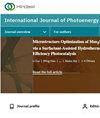A New High-Performance Photovoltaic Emulator Suitable for Simulating and Validating Maximum Power Point Tracking Controllers
IF 2.1
4区 工程技术
Q3 CHEMISTRY, PHYSICAL
引用次数: 3
Abstract
Photovoltaic (PV) research is rapidly growing, and the need for controlled environments to validate new MPPT controllers is becoming increasingly important. Currently, researchers face several challenges in testing MPPT algorithms due to the unpredictable nature of solar PV power generation. In this paper, we propose a new photovoltaic emulator (PVE) that could replace solar panels and ensure a highly controllable environment suitable for testing photovoltaic (PV) systems. In this PVE, the complex nonlinear equations of the PV cell/module are fast computed and resolved by a new linearization technique which involves the systematic breakdown of the current-voltage ( I - V ) curve of the PV into twelve linear segments. Based on input environmental conditions, an artificial neural network (ANN) was constructed to assist the linearization process by predicting the current-voltage boundary coordinates of these segments. Using simple linear equations, with the segment boundary coordinates, a reference voltage was generated for the PVE. A nonlinear backstepping controller was designed to exploit the reference voltage and stabilize the power conversion stage (PCS). The PVE was optimized using particle swarm optimization (PSO). Several tests have shown that the proposed nonlinear controller provides better dynamic and robust performance than the PI controller, the most reputable and recurrent control method in the area of PVE. The PVE was coupled with a recently proposed integral backstepping MPPT controller and analyzed under several dynamic conditions, including the MPPT test specified by EN 50530. It was found that the accuracy of the proposed PVE measured by its relative error is less than 0.5%, with an MPPT efficiency of greater than 99.5%. The attractive results achieved by this PVE make it especially suitable for simulating and validating MPPT controllers.一种适用于最大功率点跟踪控制器仿真与验证的高性能光伏仿真器
光伏(PV)研究正在迅速增长,对控制环境的需求来验证新的MPPT控制器变得越来越重要。目前,由于太阳能光伏发电的不可预测性,研究人员在测试MPPT算法方面面临着一些挑战。在本文中,我们提出了一种新的光伏模拟器(PVE),它可以取代太阳能电池板,并确保一个高度可控的环境适合测试光伏系统。在该PVE中,通过一种新的线性化技术快速计算和求解光伏电池/模块的复杂非线性方程,该技术涉及将光伏的电流-电压(I-V)曲线系统分解为十二个线性段。基于输入的环境条件,构建了一个人工神经网络(ANN),通过预测这些分段的电流-电压边界坐标来辅助线性化过程。使用具有分段边界坐标的简单线性方程,为PVE生成参考电压。设计了一种非线性反推控制器来利用参考电压并稳定功率转换级(PCS)。采用粒子群优化算法对PVE进行了优化。几次测试表明,所提出的非线性控制器比PI控制器提供了更好的动态和鲁棒性能,PI控制器是PVE领域最著名和最常出现的控制方法。PVE与最近提出的积分反步MPPT控制器耦合,并在几种动态条件下进行分析,包括EN 50530规定的MPPT测试。研究发现,该PVE的相对误差测量精度小于0.5%,MPPT效率大于99.5%。该PVE所获得的诱人结果使其特别适合于模拟和验证MPPT控制器。
本文章由计算机程序翻译,如有差异,请以英文原文为准。
求助全文
约1分钟内获得全文
求助全文
来源期刊
CiteScore
6.00
自引率
3.10%
发文量
128
审稿时长
3.6 months
期刊介绍:
International Journal of Photoenergy is a peer-reviewed, open access journal that publishes original research articles as well as review articles in all areas of photoenergy. The journal consolidates research activities in photochemistry and solar energy utilization into a single and unique forum for discussing and sharing knowledge.
The journal covers the following topics and applications:
- Photocatalysis
- Photostability and Toxicity of Drugs and UV-Photoprotection
- Solar Energy
- Artificial Light Harvesting Systems
- Photomedicine
- Photo Nanosystems
- Nano Tools for Solar Energy and Photochemistry
- Solar Chemistry
- Photochromism
- Organic Light-Emitting Diodes
- PV Systems
- Nano Structured Solar Cells

 求助内容:
求助内容: 应助结果提醒方式:
应助结果提醒方式:


